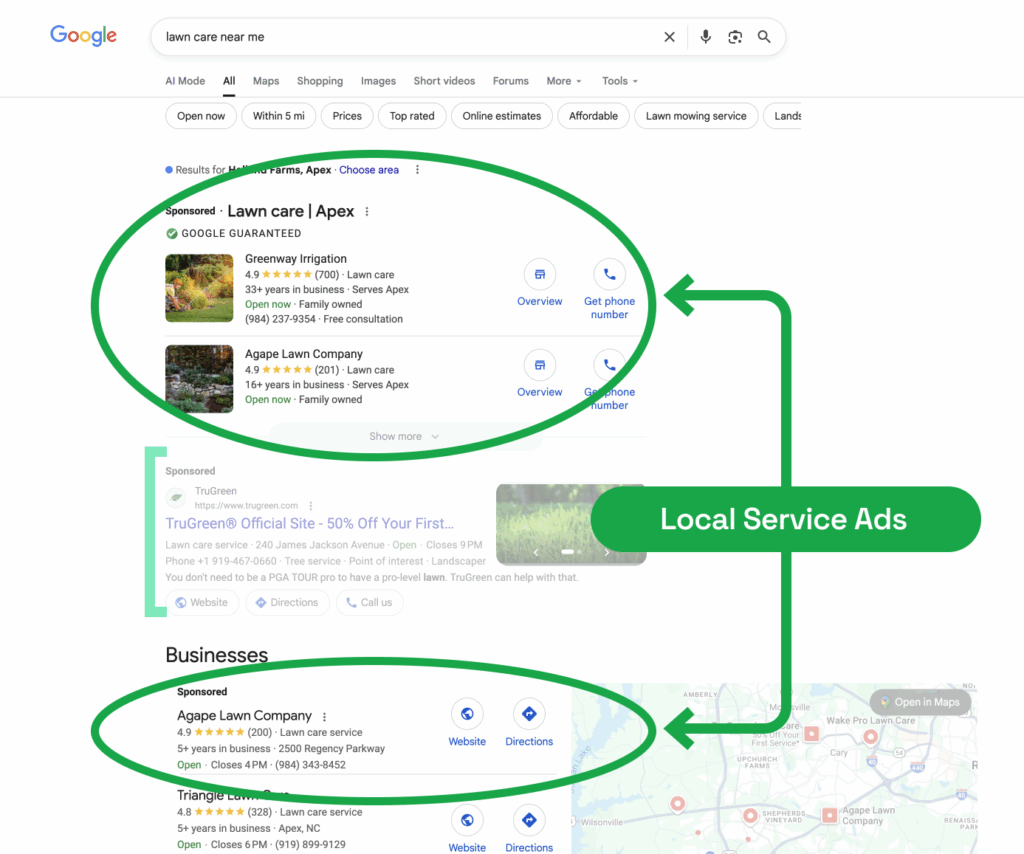Most local businesses think about facebook/instagram advertising, but that’s step 2. You want to get to the top of Google maps and suggested businesses? The first place to look is Google Local Service Ads.
Google Local Service Ads (LSAs) aren’t just another paid advertising channel. They’re the front door to your market—the first thing potential clients see before they even reach organic search results. For local B2B service businesses, LSAs represent a fundamental shift in how customers find and vet service providers.

What sets LSAs apart: Google explicitly vouches for your business. That Google Guaranteed badge isn’t decorative. It signals trust at the exact moment a prospect is deciding who to call.
Traditional Google Ads charge you for clicks. Someone sees your ad, clicks through, looks around, and leaves. You pay regardless of whether they had any genuine interest or budget.
LSAs charge you only when a prospect contacts you directly—a phone call, a message, a booking request. You’re paying for demonstrated interest, not casual browsing.
This fundamental difference transforms the economics of local advertising. Every dollar spent represents an actual lead in your pipeline. The quality threshold is built into the pricing model.
Placement: LSAs appear above all other search results, including traditional paid ads and organic listings. Your business occupies the most valuable digital real estate in local search.
Trust signals: The Google Guaranteed badge provides third-party validation. Potential clients see your review count, average rating, and response time before they click. This pre-qualification works in your favor—serious prospects contact you, tire-kickers scroll past.
Mobile optimization: LSAs are purpose-built for mobile search. One tap initiates a phone call. For service businesses, where immediate contact drives conversions, this friction reduction is transformative.
Market coverage: If you’re not running LSAs in a category where they’re available, your competitors are capturing leads you should own. This isn’t optional exposure—it’s defensive positioning.
Lead costs vary significantly by market, competition, and service category. A few benchmarks:
Geographic factors drive variance. Major metros command premium rates. Suburban and rural markets typically cost 30–50% less per lead.
Budget requirements: Google doesn’t publish minimum budgets, but practical experience suggests starting with $500–$1,000 monthly to generate meaningful volume. Smaller budgets risk inconsistent lead flow, which makes performance assessment difficult.
You control maximum lead costs. Set per-lead price caps. When competition drives costs beyond your threshold, your ads simply don’t show. This prevents runaway spending in heated auctions.
Standard LSA conversion rates for local service businesses range from 10% to 40%, depending on several factors:
Most local B2B service businesses should expect 15–25% conversion from LSA lead to closed customer with competent sales follow-through.
Here’s the framework to determine if LSAs make economic sense for your business:
Example: A commercial HVAC contractor averages $8,000 first project value, with 60% of clients returning for maintenance or additional work worth $12,000 over three years. CLV = $20,000.
Standard benchmark: CAC should be ≤ 20–30% of CLV for sustainable growth.
Using the HVAC example: 25% of $20,000 CLV = $5,000 maximum CAC.
CAC threshold: $5,000
Actual CAC via LSAs: $250
Available margin: $4,750
This represents a 20:1 return on acquisition investment. LSAs are overwhelmingly profitable in this scenario.
LSAs struggle when:
Google’s requirements aren’t trivial:
This barrier to entry is your competitive advantage. Many small businesses can’t or won’t complete the verification process. If you can, you’re competing against a smaller pool.
Ongoing management requirements:
LSAs aren’t just lead generation—they’re market position defense. In local B2B service markets, visibility equals viability. When prospects search for your service category, they’re comparison shopping the top three results. If you’re not there, you’re invisible.
The first-mover advantage compounds. Early LSA adopters in a category accumulate reviews faster, achieve better placement, and pay lower per-lead costs. Late entrants face established competitors with 50+ reviews and years of optimization.
This is infrastructure, not experimentation. Treat LSAs as core business infrastructure, not a marketing test. Consistent presence builds brand recognition. Intermittent participation wastes money without generating returns.
Before launching LSAs, document your unit economics:
If the math works, commit budget for 90 days minimum. LSA performance improves with profile maturity. Week-one results don’t represent steady-state performance.
If the math doesn’t work, fix your pricing or service mix before blaming the channel. LSAs expose weak unit economics. Businesses with strong economics thrive. Businesses with marginal economics struggle regardless of lead source.
The businesses winning with LSAs aren’t running sophisticated campaigns. They’re answering their phones quickly, providing clear pricing, and delivering excellent service that generates reviews. The mechanics are simple. The discipline is what separates winners from everyone else complaining about lead quality.
Hip Bip solves the website problem for small service businesses by providing American-made websites that actually make money and lower business owner stress.
Hip Bip solves the website problem for small service businesses by providing American-made websites that actually make money and lower business owner stress.
Provided with ❤️ from HBCO.AGENCY.
© 2025 Hippidy Bippidy Co. All rights reserved. Terms & Privacy